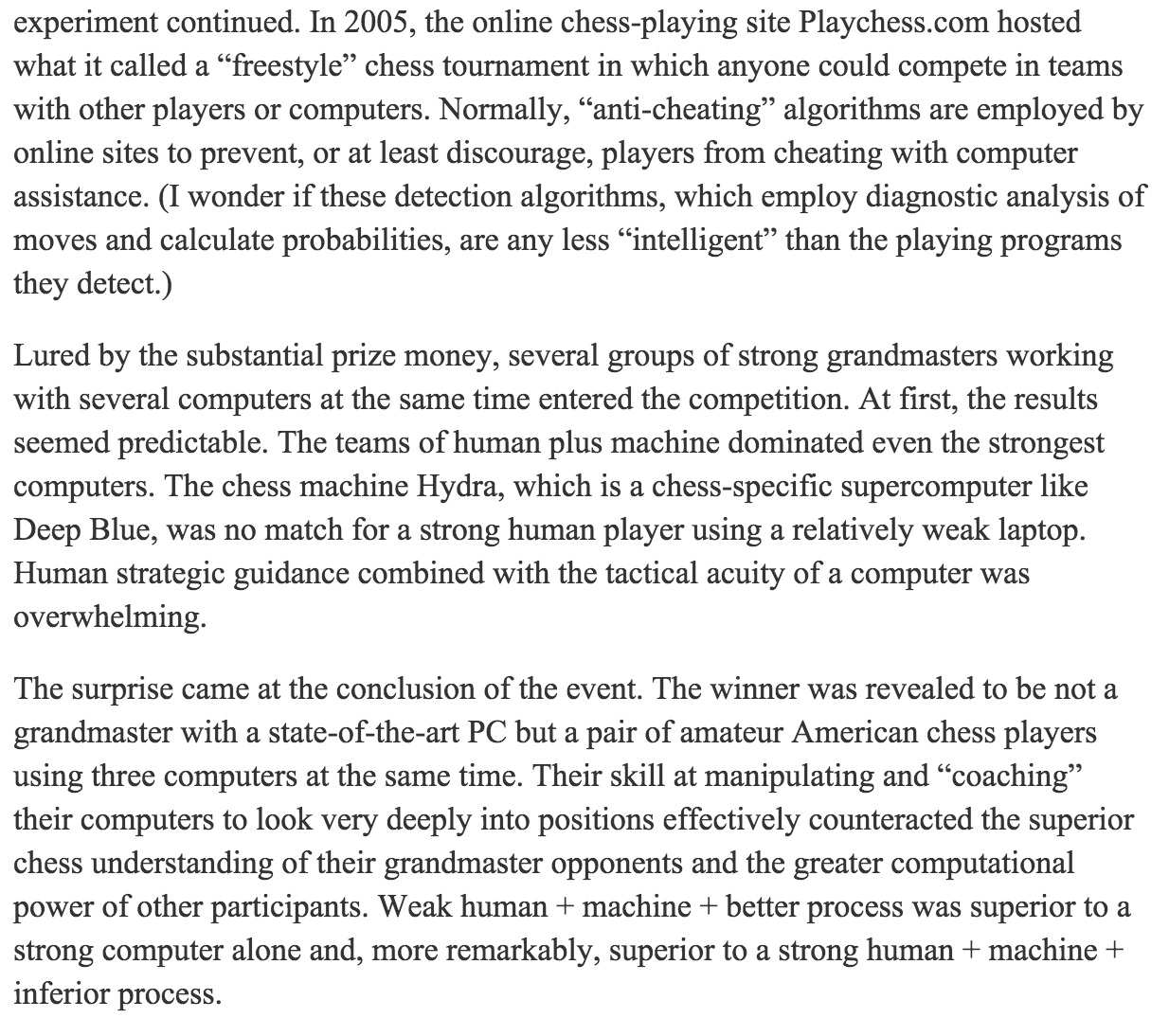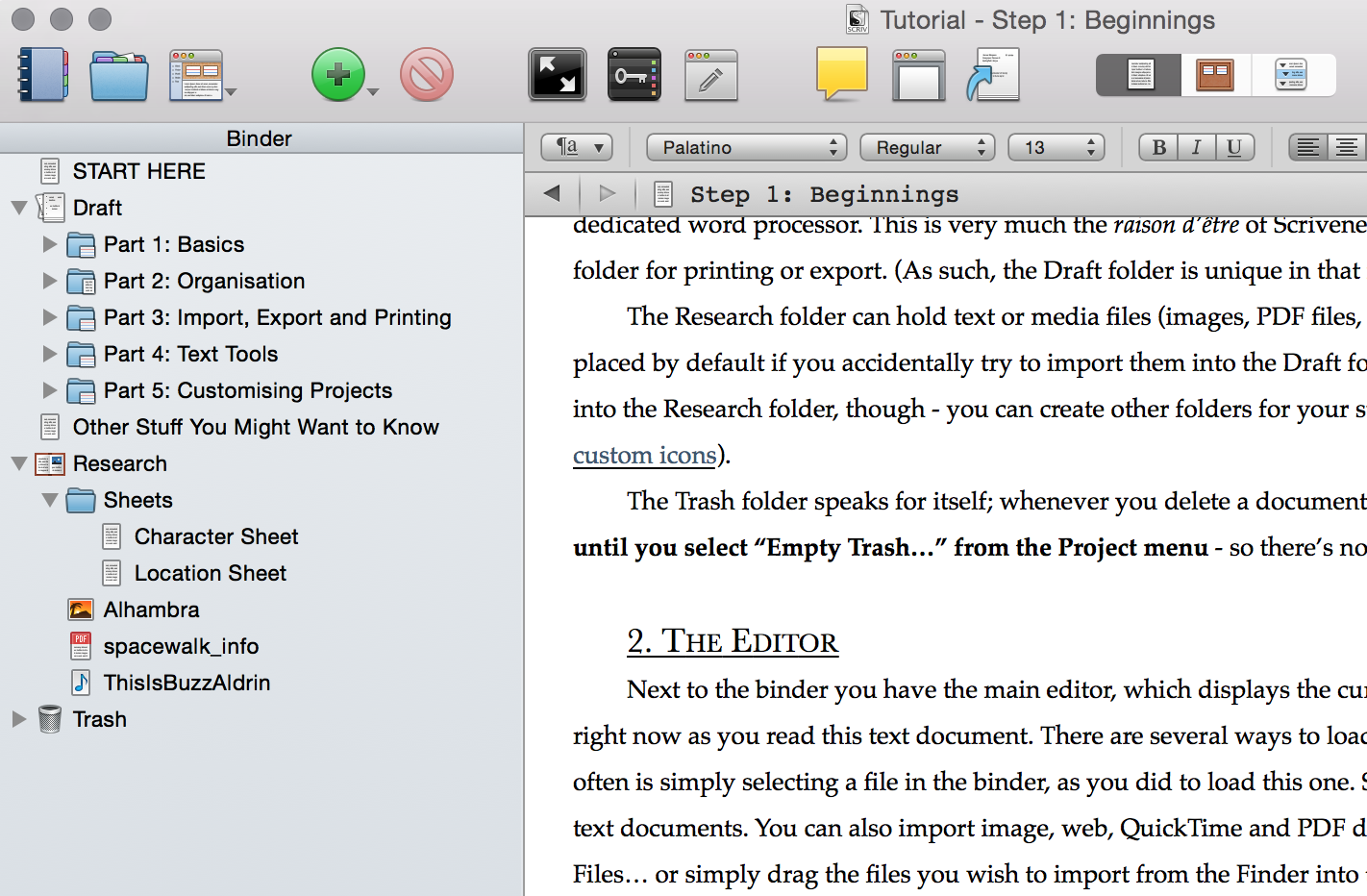Engelbart: "Augmenting Human Intellect"

 “By "augmenting human intellect" we mean increasing the
capability of a man to approach a complex problem situation,
to gain comprehension to suit his particular needs, and to
derive solutions to problems… whether the problem
situation exists for twenty minutes or twenty years. We do not
speak of isolated clever tricks that help in particular
situations. We refer to a way of life in an integrated domain
where hunches, cut-and-try, intangibles, and the human "feel
for a situation" usefully co-exist with powerful concepts,
streamlined terminology and notation, sophisticated methods,
and high-powered electronic aids. ”
“By "augmenting human intellect" we mean increasing the
capability of a man to approach a complex problem situation,
to gain comprehension to suit his particular needs, and to
derive solutions to problems… whether the problem
situation exists for twenty minutes or twenty years. We do not
speak of isolated clever tricks that help in particular
situations. We refer to a way of life in an integrated domain
where hunches, cut-and-try, intangibles, and the human "feel
for a situation" usefully co-exist with powerful concepts,
streamlined terminology and notation, sophisticated methods,
and high-powered electronic aids. ”
Source text for Engelbart's paper on “Augmenting Human Intellect”.
Slides by Michael Nielsen, for a small-group discussion with people from the Recurse Center, August 10, 2015. The slides should be regarded as brief, rough and very(!) incomplete working notes on a tiny slice of Engelbart's paper.
Augmenting intellect with paper and pencil
What is 427 x 784?
Hard for an unaided human.
Even harder: what is 721,269,127 x 422,599,421?
Both problems become easy with paper and pencil.
This is strange, a priori: wood pulp + wood + graphite = more intellectual capability!
We're used to this, but that doesn't mean we understand it. What's actually going on? For what class of problems does paper and pencil help? For what class of problems does it not help (or hinder)? How much can it help?
Advanced chess
Garry Kasparov, writing in the 2010 New York Review of Books:

Questions
Is there a theory of how humans and machines work together? Or, at the least, some general principles governing behaviour?
Can we find principles that will help us design more powerful human-machine systems?
Engelbart's paper sketches out a research program that aims toward – very roughly speaking – these ends.
Because the paper is a sketch it is often highly speculative, and sometimes rather vague. It's more a cool-headed manifesto than a typical paper. We won't attempt to grok the whole thing – indeed, I certainly don't grok the whole thing. Instead, we'll focus narrowly, and try to begin understanding a few of the deep ideas.
In other words, I'm riffing on the paper, drawing connections to other work, and asking questions. Please jump in!
Problem solving as symbol structuring
Writing a book is the art of “sitting down and putting a hundred thousand words in a cunning order” (Douglas Adams)
Engelbart viewed augmentation as being to a great extent about developing new ways of manipulating and structuring symbols:
“One way of viewing the H-LAM/T system changes that we contemplate--specifically, integrating the capabilities of a digital computer into the intellectual activity of individual humans--is that we are introducing new and extremely advanced means for externally manipulating symbols. We then want to determine the useful modifications in the language and in the way of thinking that could result.”
Examples of systems for structuring symbols: the multiplication algorithm, diary, calendar, GTD, org-mode, outlining tool, Word, Emacs, etc.
Scrivener

Scrivener is a popular outlining tool used by writers.
I suspect much of its popularity is due to one piece of symbol structuring it does: a clear, built-in division between research notes and draft material, making it easy to jump back and forth.
The creators of Scrivener have taken a process that formerly had to be done manually by writers, and built a system of cues that make it easy and natural.
It's not difficult for a writer with the right habits to do this manually. But Scrivener makes it hard to avoid, providing all the right cues at the right moments.
In other words it provides an environment for the simple process stuff done by experts.
Capabilities
Engelbart divides our (augmented) problem-solving capabilities up:
- Basic capabilities;
- The repertoire hierarchy of capabilities, built up from the basic capabilities.
This division is a very clever move.
It's tempting to focus primarily on changes to basic capabilities. Many of those changes will appear trivial.
By also concentrating on the repertoire hierarchy as an important object of study, we are alerted to the fact that even a tiny change to basic capabilities may propagate through the repertoire hierarchy to cause major changes in effective intellect.
Scrivener's division into research and draft is only a small addition to the basic capabilities. But it propagates all through the writing process to cause a major change in results.
Questions
What are some other examples of small changes in basic capabilities that cause large changes in the repertoire hierarchy?
In particular, can we think of really small changes that give rise to huge changes in the reportoire hierarchy?
Possible sources of inspiration may come from: Emacs, Word, GTD, diary, your favourite programming language, etc.
Can we think of characteristics that mean a small change will have an especially large impact?
The impact of our means of manipulating symbols
“The Whorfian hypothesis states that the world view of a culture is limited by the structure of the language which that culture uses. But there seems to be another factor to consider in the evolution of language and human reasoning ability. We offer the following hypothesis, which is related to the Whorfian hypothesis: Both the language used by a culture, and the capability for effective intellectual activity are directly affected during their evolution by the means by which individuals control the external manipulation of symbols.”
Ken Perlin's widgets
Play from 47:10 through 53:05. Original source.
Symbols are no longer static. They're dynamic, interactive. They have both a user interface and the ability to interact with one another. If the symbols are well-designed, there is the potential for emergent, collective behaviour, and new forms of meaning (as with language). Giving more powerful means of expresion changes the basic capabilities, and, if well chosen, this may affect the entire repertoire hierarchy.
Questions
What other examples are there of introducing new symbols for expresing thought?
What makes a new symbol particularly powerful? What makes a new symbol weak?
What would be some fun things to prototype?
What's missing from Engelbart's paper?
He views problem solving as being all about information handling: symbol structuring.
But there is a very large – maybe primary – factor, which is emotional involvement.
Someone deeply committed with bad tools is often much more effective than someone uncommitted who has great tools.
How can we use computers to change people's emotional experience?
Papert's Mindstorms is pretty good on this.
Notes
The following rough notes were made by participants in the discussion:
/